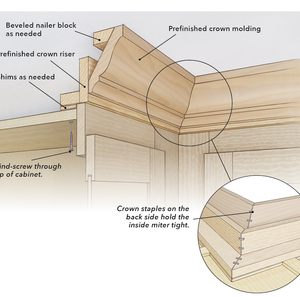Hey guys. I have a quick question for you. What is the best way to attach half inch dryywall to a concrete wall, or is this even possible?
Discussion Forum
Discussion Forum
Up Next
Video Shorts
Featured Story

Listeners write in about tools and California wildfires before asking questions about rotting exteriors, leaky garage roofs, and replacing concrete basement floors.
Highlights
"I have learned so much thanks to the searchable articles on the FHB website. I can confidently say that I expect to be a life-long subscriber." - M.K.
Fine Homebuilding Magazine
- Home Group
- Antique Trader
- Arts & Crafts Homes
- Bank Note Reporter
- Cabin Life
- Cuisine at Home
- Fine Gardening
- Fine Woodworking
- Green Building Advisor
- Garden Gate
- Horticulture
- Keep Craft Alive
- Log Home Living
- Military Trader/Vehicles
- Numismatic News
- Numismaster
- Old Cars Weekly
- Old House Journal
- Period Homes
- Popular Woodworking
- Script
- ShopNotes
- Sports Collectors Digest
- Threads
- Timber Home Living
- Traditional Building
- Woodsmith
- World Coin News
- Writer's Digest


















Replies
Buildinman
You can strap the wall with 1x3 using tapcons or concrete nails.
You can strap the wall with metal strapping using same or shoot it on.
You can glue the drywall directly to the concrete and hold in place with concrete nails.
Just a few of the ways
Gabe
Any risk of moisture wicking to the paper backing w/o the air channel that strapping would give?
If it's an exterior wall that has no effective dampproofing on the opposite side, of course you will have a problem. Wicking would be the least of them.
Applying the drywall directly to the masonry or concrete is something that I normally only do to dividing walls on the interior. The exterior, because of conditions here, is always over some type of insulation and vb, studs or strapping being insuficient by themselves.
Air space in itself is also insuficient. The best thermal R expected by an air space would be R .5. The metal studs by themselves would cause serious bridging between the cold and warm sides.
Wall systems have to take into consideration all aspects of the individual components as well as all the components together, as a single unit.
Gabe
Thanks. What had me thinking about this was our big ol' main slab inside. I didn't put stuff on the floor for a month or so after it was poured. Then I stacked the boxes of flooring hither and yon. Later when I moved them, the bottom ones showed every indication of having been damp on the bottom, plus the concrete had that dark spot you see when one area of a curing slab is covered and the surrounding area isn't. If it had been sheetrock glued to that spot, it'd have been more messed up than my cardboard box was.
Of course, a wall isn't a floor, and a box isn't sheetrock. But are there, for example, moisture testing guidelines for gluing sheetrock to concrete walls, such as the guideline I had of <5% in the gypcrete before I laid tile/flooring? If nothing other than to avoid mold/mildew growth between the two...
Cloud Hidden,
Yes there are specified moisture guidelines for applying various finishes to concrete walls. Various products require that the concrete be cured for anywhere from 21 days to 6 weeks and the moisture content be anywhere from 4% to 15%. I'll have to look up drywall specifically later.
I loaned my gypsum book and will hunt it out. Film at 11.
On an exterior concrete wall, given any unknowns, I would create a drain plane for moisture to escape. Always better to be safe when it's your dime and needs.
Concrete, metal furring(verticals only, (no base or top piece), poly and MR drywall.
Gabe
Locally, our houses are specified to include an exterior drainage plane over the dampproofing.
Edited 3/22/2002 12:44:52 PM ET by Gabe Martel
If you choose to glue the drywall directly to the concrete, use Durabond or any other setting type drywall mud and trowel it on with a heavy notched trowel and stick the board to it.
Terry
Has anyone used the GOLD-WALL insulation system? Commercial or residential?
http://www.plymouthfoam.com
Come on, you would support your wall system with Durabond?
I would Z-strip the wall and make sure my seams met for finishing.
I can only speak from my own expirence. Durabond sticks to concrete and drywall tenaciously.
By using this, I can trowel larger areas of this "adhesive" over the concrete wall then I would easily be able to do with construction adhesive. I pay extra attention to the seams and butt joints, making sure they are covered. Depending on the amount of area I am trying to cover, I will either prop or wedge the drywall with kickers, or when needed, I will use Tapcons to fasten a few furing strips over the face of the drywall. As I typically use 45 min Durabond, within an hour, I can remove these temporary braces.
My first choice is to frame up a freestanding wall - but sometimes the situation does not allow.
Terry
There are many ways to play this. I would shoot z-strip over a vb, and fill with poly-iso. Screw the board to the Z's and finish.
EnerBond SF or Enerbond DW.
Phill Giles
The Unionville Woodwright
Unionville, Ontario